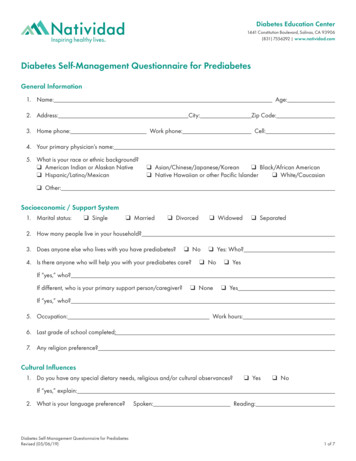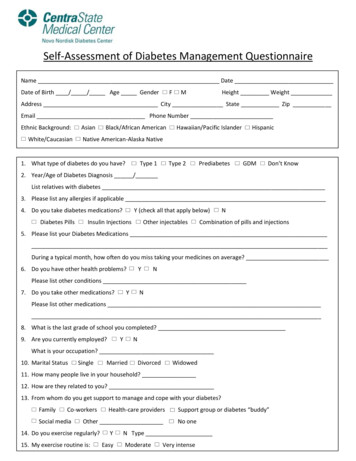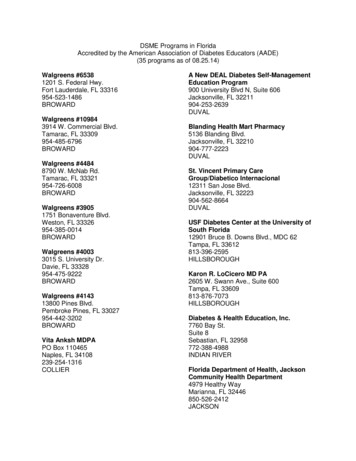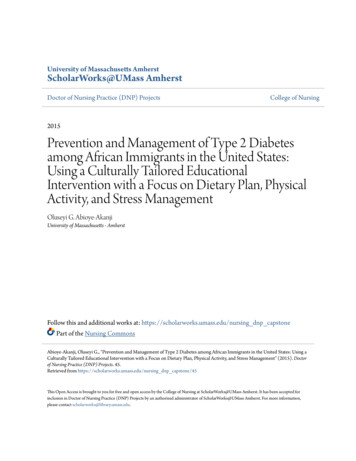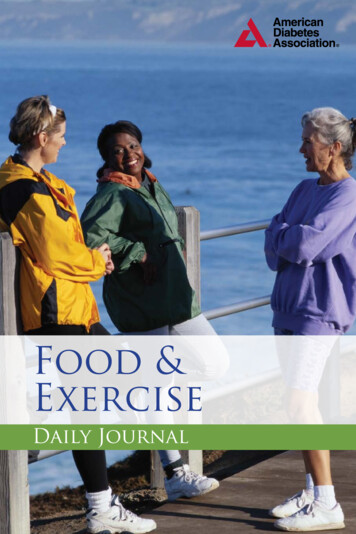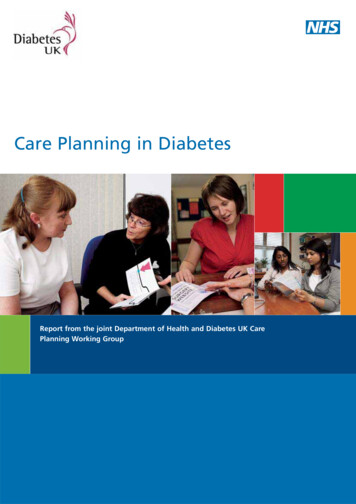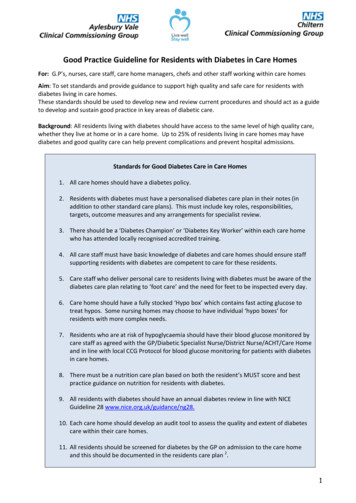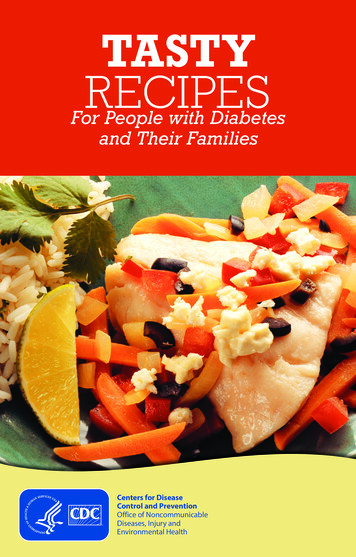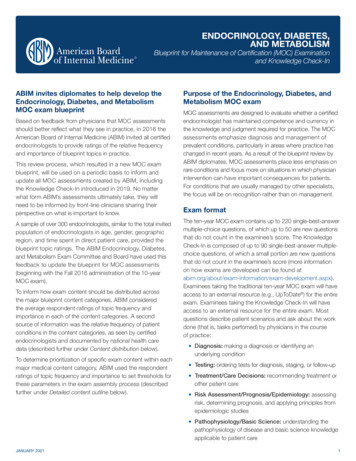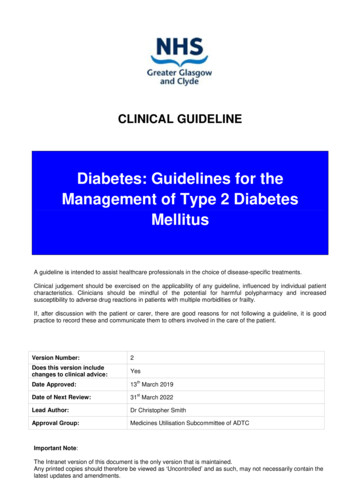
Transcription
CLINICAL GUIDELINEDiabetes: Guidelines for theManagement of Type 2 DiabetesMellitusA guideline is intended to assist healthcare professionals in the choice of disease-specific treatments.Clinical judgement should be exercised on the applicability of any guideline, influenced by individual patientcharacteristics. Clinicians should be mindful of the potential for harmful polypharmacy and increasedsusceptibility to adverse drug reactions in patients with multiple morbidities or frailty.If, after discussion with the patient or carer, there are good reasons for not following a guideline, it is goodpractice to record these and communicate them to others involved in the care of the patient.Version Number:2Does this version includechanges to clinical advice:YesDate Approved:13 March 2019Date of Next Review:31 March 2022Lead Author:Dr Christopher SmithApproval Group:Medicines Utilisation Subcommittee of ADTCthstImportant Note:The Intranet version of this document is the only version that is maintained.Any printed copies should therefore be viewed as ‘Uncontrolled’ and as such, may not necessarily contain thelatest updates and amendments.
Contents1. Introduction (3)2. Diagnosis (4)3. Lifestyle/Weight Management (4)4. Stratification (7)5. Pharmacotherapy Algorithm (8)6. Subgroup Guidance (9)7. Drug Classes (10)8. Diabetes, Prevention and Management of Associated Complications (11)9. Pregnancy and Type 2 Diabetes (11)10. References (11)2
IntroductionThis updated guideline is written in the context of the latest SIGN update (154)1 and “Qualityprescribing for Diabetes” 2, whilst incorporating the principles of “Practicising Realistic Medicine”3and “The Modern Outpatient” 4. The intention is to support care and support planning byempowering patients to make individualised choices with regard ongoing management plans fortheir multi-morbidities. In particular we hope to support the increasing use of House of Care5 modelsacross the health board, with GPs as the expert generalist supporting informed patients to makeindividualised care plans to manage their co-morbidities.We aim to comply with the core principles of “The Modern Outpatient:-” 4 Strengthening knowledge exchange and self-management in the community with the patientat the centre, Accessing decision support, care planning and care services in the community wherever safeand appropriate Emphasising competency-based roles in secondary care, to focus Consultant resource onmore complex patients, and recognising the role of the GP as the ‘expert clinical generalist’and raising the profile and enhancing the role of the wider multidisciplinary team ofcommunity-based practitionersAnd 2) “Practising Realistic Medicine” 3 Empower people and communities to take their rightful place at the centre of decisionmaking.3
Acknowledging the now well established clusters of primary care practices within the health board,we now have a clear vision of how the vast majority of type 2 diabetes care can be offered in thecommunity with easy access to timely specialist support for appropriate patients.cDSN- patient and AHPEmail, Sci-gateway, phone, clusterMDTsGP, Practice nurse,AHPs (including nonmedical prescribers)- review- care planning- stratification- intensification- education- CV risk management- complication Rx- liaison with cDSNand lead consultanteducation- GLP1 and basal insulininitiation-- liaison with primary careand lead consultantPerson withType 2 DiabetesEmail,phone,ClusterMDTConsultantEmail, Sci-gateway, phone,cluster MDTsrd- above target after 3 line- diagnostic dilemma(young, low BMI, pancreatichistory)- AHP education- insulin intensificationDiagnosisAt point of diagnosis, people should be directed to relevant approved literature (informationleaflets, websites etc) as well as offered referral to local structured education (currently“Conversation Maps”), and consideration of Weight Management referral if appropriate. As perSIGN, consider setting HbA1c target of 48 initially without medical therapy.If clinical concern (rapid weight loss, significant symptoms, ketosis etc) seek urgent advice from localDiabetes centre or link consultant. Similarly, if concerned over diagnosis (features as above,pancreatic history, low/normal BMI, significant family history, young age), request diagnosticassessment from specialist.Lifestyle/Weight ManagementPeople with Type 2 diabetes should be encouraged to achieve and maintain a healthy BMI, as thiswill help manage the condition and decrease the potential need for escalating medical therapy.Initial results from the well publicised DiRECT study have shown significant remission rates (HbA1c 48) for overweight patients with type 2 diabetes within 6 years of diagnosis if significant weight lossachieved (86 per cent of people who lost more than 15kg on the programme were in remission aftera year, as were 57 per cent of people who lost 10–15kg, and 34 per cent who lost 5–10kg). 64
When considering whether you should raise the issue of weight with a patient with type 2 diabetes,it is important to take account of their overall physical and emotional state. For example, if they area heavy smoker or are struggling to cope with the loss of a family member then discussing thoseissues first may take priority. Behaviour change is most successful when a patient’s lifecircumstances are understood and taken into consideration, a general question to establish thepatient’s current circumstances can help establish priorities.GWMSBefore considering weight management as an option for any patient with type 2 diabetes you shouldconduct a full medical review. This should include an assessment of any comorbidities that couldpose potential risks during weight management, and consideration as to whether any of theircurrent medications could be impacting on their weight. It is important not to make any assumptionsabout whether weight management is a priority for your patient or not. Even if you have discussedthe possibility of weight management before, and at that time it was not a priority, this may notmean that they do not want to engage now. Likewise, do not assume that weight management is ofimportance to them without first discussing it with the patient.Access to lifestyle and specialist weight management services including bariatric surgery is viaGreater Glasgow and Clyde Weight Management Service. Referral is via Sci-Gateway or paper form(downloaded via link below). There is one form for all patients and the referral hub will triage to theappropriate service. Certain patients with Type 1 and Type 2 diabetes , and also those with heartdisease or previous stroke, can also self-refer. It is vital to give a current phone number for thepatient, ideally a mobile, as the patient will be phoned to book into a programme once the referral isreceived. It is best practice to also give the patient the information leaflet describing the servicewhich can be downloaded from the website. Referrers have continued responsibility to monitorconditions such as T1/2 diabetes during weight loss.Link to weight management referralDiabetes specific referral criteria (criteria for other conditions as per link above)BMISelf-referral criteria 25 (22.5*) 30 (27.5*)Health professional referral criteria 25 (22.5*) 25 (22.5*) 30 (27.5*)Bariatric surgery criteria (triaged by servce)ConditionType 2 diabetesType 1 diabetesHeart diseaseStrokeImpaired fasting glucose/ Impaired glucosetolerance/ High diabetes risk/ Previous GDMType 2 diabetesType 1 diabetesType 2 diabetes ANDBMI 35-55 ANDAge 18-55 ANDDiabetes diagnosis 10 years5
* Patients with South Asian/Chinese/middle Eastern Ethnicity have a lower BMI thresholdPeople with diabetes and BMI 30 can self-refer via dedicated phone line (0141 211 3379 Monday –Friday 8:00am – 4 pm, as per link above).Triage destination (diabetes related only; for others see link above)Community Weight Management Service(currently Weight Watchers)T2DMBMI 25 (22.5*)Specialist Weight Management ServiceT2DMBMI 45T1DMPotential bariatric surgerypatient (as per criteria)BMI 45BMI 35(patients who meetssurgical criteria will betriaged to specialistservice)T1DMImpaired fastingglucose/ impairedglucose tolerance/BMI 30 (27.5*)BMI 25 (22.5*)Exceptional referrals for bariatric surgeryIf a GP or Consultant wishes a patient who is outside the current surgery criteria to be considered asan exceptional case for surgery, they can ask for the case to be considered at the BariatricExceptional Referrals panel. A full outline of the case should be submitted in writing to:Mark DaleClinical Service ManagerGeneral Surgery and Breast - North Sector4th Floor Walton BuildingGlasgow Royal InfirmaryOffice: 0141 211 5076Bariatric SurgeryPatients undergoing bariatric surgery on therapy for type 2 diabetes should have a clear pre- andpost- op plan in relation to treatment modification.Patients using oral medication may need dose reduction of medication, in particular sulphonylurea,pre-op during the calorie restriction phase. Post op, metformin will likely be continued and othernon-insulin therapy (including GLP1 agonist) will be withheld. Patients on insulin need to be advisedon management of dose as all are encouraged to lose weight during the 3-4 months running up tosurgery.For patients on insulin therapy, pre-op whilst on calorie restriction doses will have to be reduced byat least 10%. Post-op, doses will be reduced by at least 50% and closely monitored. Insulin dosingplans should be confirmed with the relevant link consultant Diabetologist.6
Stratification: Intensification and Conservative/MonitoringA – Target achieved (national or individualised): MonitoringB – Target not achieved: Active IntensificationC – Target not achieved: MonitoringIntensification complete, drug intolerance/adherence, patient decisionD – Disengaged from health careB - INTENSIFICATION1st line agentArrange 3/12 HbA1cEmphasise thebenefits of achievingand maintaininghealthy BMIA C -MONITORINGTarget HbA1cachieved (eg 53mmol/mol)2nd line agentHbA1c 3/12Arrange 6-12monthlyHbA1c3rd line agentIf HbA1cabove target,back into RxalgorithmHbA1c 3/12Stop medicationif individualisedtarget notachieved ANDHbA1c falls lessthan 0.5%(5.5mmol/mol).Consideralternative fromsame Rx line.4th line agent (typicallyneed specialist support)GLP1 or basal insulin start(with cDSN support)*HbA1c 3/12Insulin intensificationbeyond basal insulin ieintroduction of prandial orpremix regimes (casereviewed by specialist)** consider referral tospecialist dieticianwhen commencinginsulin7
Pharmacotherapy algorithm (adapted from SIGN 154)FIRST LINEMETFORMIN*SU**SGLT2i (if BMI 30or CV disease)AdvantagesWeightCVLow hypo riskEfficacyWeight lossCV (and BP)Low hypo riskCautions/ side effectsGIHyposWeight onsCKD 4CKD 3a (initiation)Frailty*Alternative to metformin if contraindicated or not tolerated** Only where metformin is contraindicated or not tolerated and where a sulphonylurea is not appropriate.SECOND LINESGLT2iSUDPP4iPioglitazoneAdvantagesWeight lossCV (and BP)Low hypo riskEfficacyWeightLow hypo risktoleratedEfficacyLow hypo riskCautions/ sideeffectsDiureticsThrushKetosisHyposWeight gainFrailtyBGMEfficacyCKD (adjustment)OedemaCentral adiposityosteoporosisContraindicationsCKD 3a (initiation)FrailtyPancreatic historyCCFBladder cancer(haematuria)THIRD LINE3rd agent from 2nd lineGLP1 RAO.D. insulinAdvantagesAs aboveEfficacyCautions/ side effectsAs aboveEfficacyWeight lossCVLow hypo riskGIInjectionsContraindicationsAs aboveFOURTH LINEHyposWeight gainBGMInjectionsPancreatic historyCKD 4 (egfr 15 forsome)Specialist input (cDSN and/orconsultant)If 1 insulin injection requiredshould be offered clinicreview until stable8
Subgroup guidanceObesity or CV diseaseIf known CV disease, choose SGLT2i or GLP1 RA with proven CV benefit.*Alternative to metformin if contraindicated or not toleratedFIRST LINEMETFORMIN*SU*SGLT2i (ifBMI 30 or CVdisease)SECOND LINESGLT2iSUDPP4iTHIRD LINEGLP1 RA3rd agent from2nd lineO.D. insulinPioglitazoneElderly/FrailRelaxing glycaemic target may be appropriate eg HbA1c 65-75 mmol/mol, and concentrating ontreating symptoms whilst minimising risks of potential side effects like hypoglycaemia.FIRST LINEMETFORMIN*SU*SGLT2i (ifBMI 30 and orCV disease)SECOND lozin 6045-60Reduce dose / don’tinitiateContinue/ don’t initiateReduce dose / don’tinitiateReduce dose if eGFR 50Reduce dose if eGFR glutideDulaglutideCaution if eGFR 50ExenatideStop 50Exenatide MRCaution if eGFR 50LixisenatideThe table provides guidance please refer to BNF /SPCPioglitazone30-44 30Reduce doseCautionNoNoCautionNoNoNoNoNoReduce doseReduce doseReduce dose furtherReduce dose furtherCautionNoCautionStop 15Stop 15NoNoNo9
Drug ClassesBiguanides (Metformin)Metformin should be considered first line treatment for people with type 2 diabetes.Optimal dose 1g twice a day with meals, titrated from 500mg once a day. Generally acceptedpatients will continue with metformin unless not tolerated or contraindicated due to prognosticbenefit.SulphonylureasSulphonylureas should be considered as first-line agents for people intolerant of metformin, or inwhom metformin is contraindicated, and not suitable to consider SGLT2i (CV disease or obesity).Sulphonylureas should be considered as second- and third- line add on therapy in combination withother oral agents. Appropriate advice and access to blood glucose monitoring should be considered,in relation to risk of hypoglycaemia.SGLT2 inhibitorsSGLT-2 inhibitors with proven CV benefit (currently empagliflozin7, canagliflozin8, and dapagliflozin9)should be considered as add-on therapy to metformin in people with type 2 diabetes. For those withestablished CVD or heart failure, these may be considered first line if metformin is not suitable (
Management of Type 2 Diabetes Mellitus : 2 : Contents : 1. Introduction (3) 2. Diagnosis (4) 3. Lifestyle/Weight Management (4) 4. Stratification (7) 5. Pharmacotherapy Algorithm (8) 6. Subgroup Guidance (9) 7. Drug Classes (10) 8. Diabetes, Prevention and Management of Associated Complications (11) 9. Pregnancy and Type 2 Diabetes (11) 10. References (11) 3 : Introduction : This

